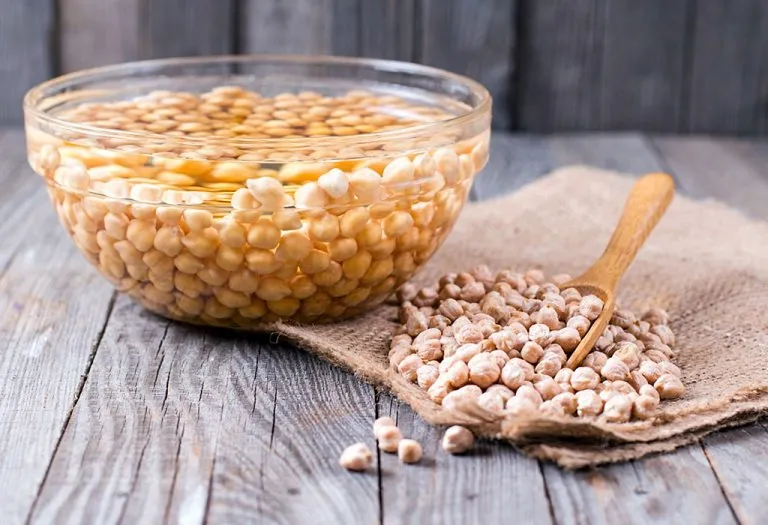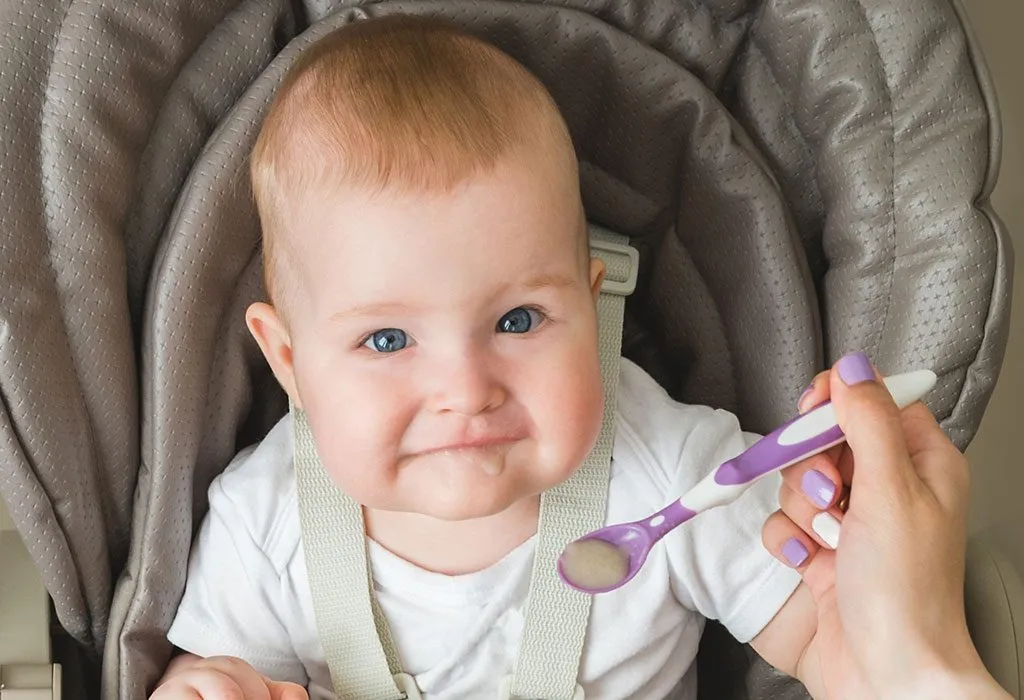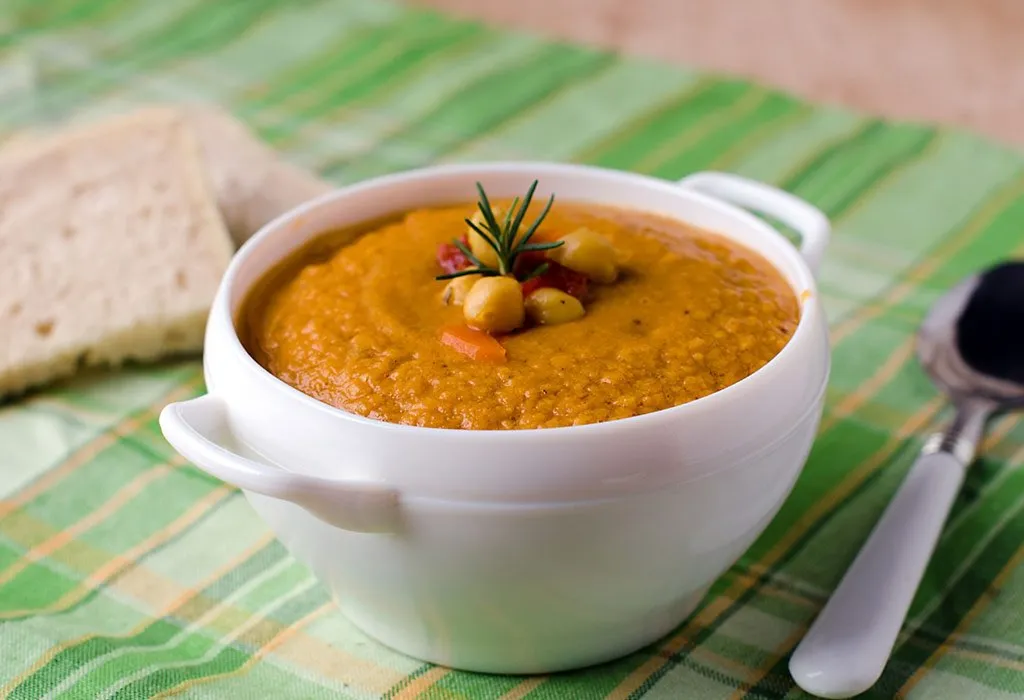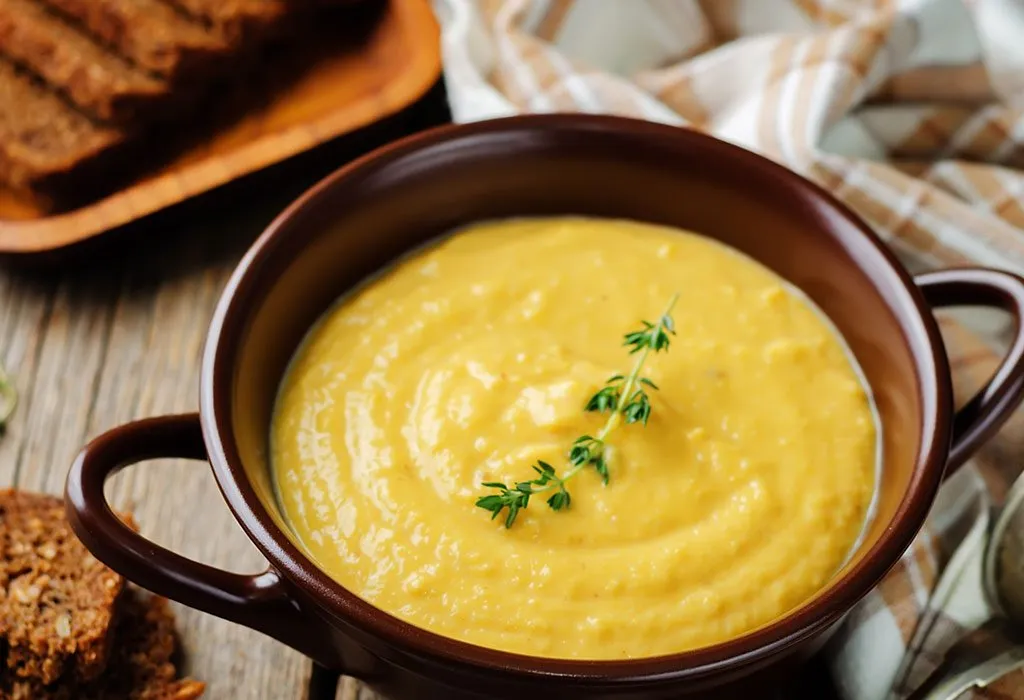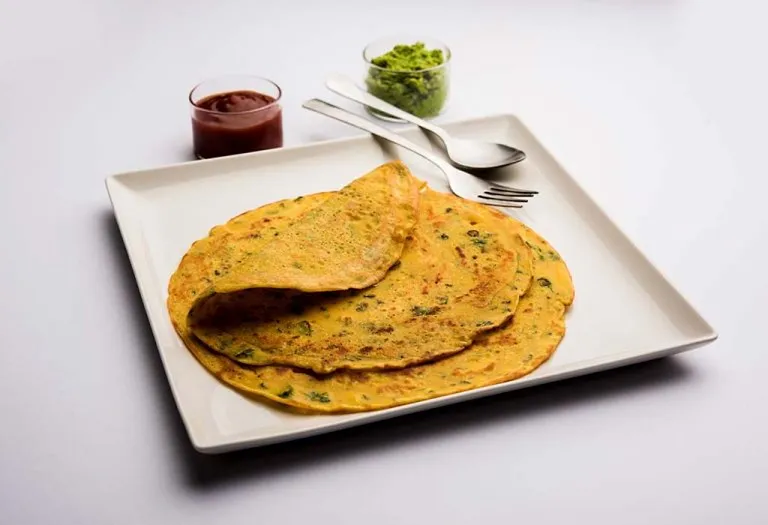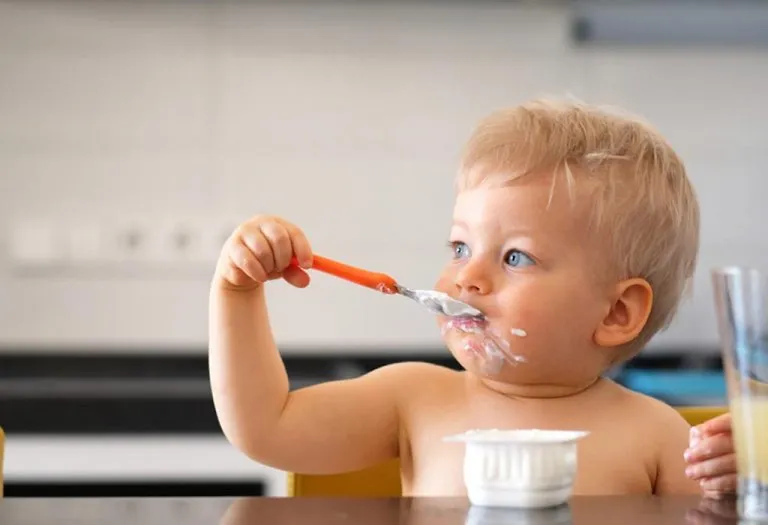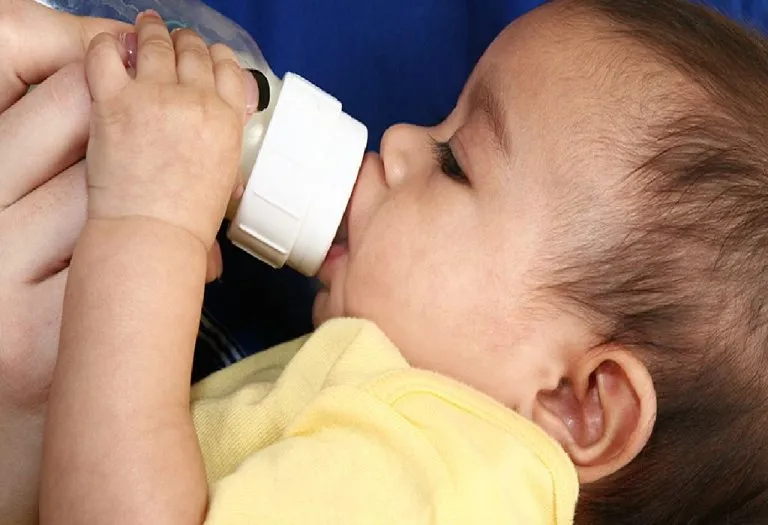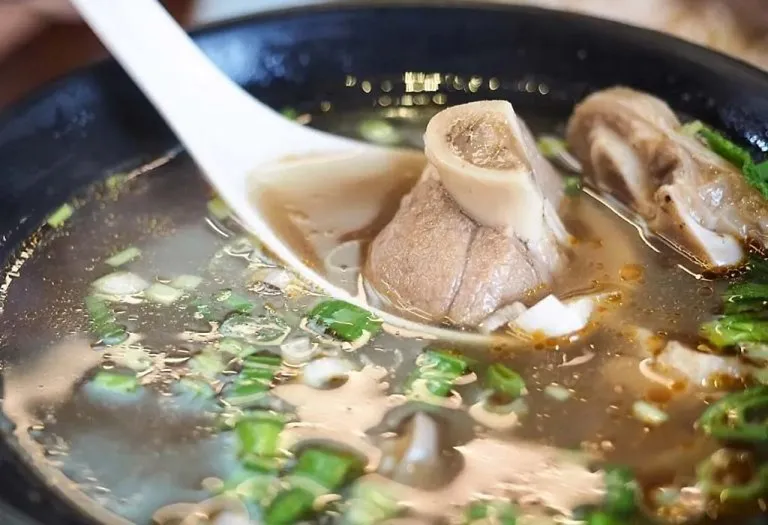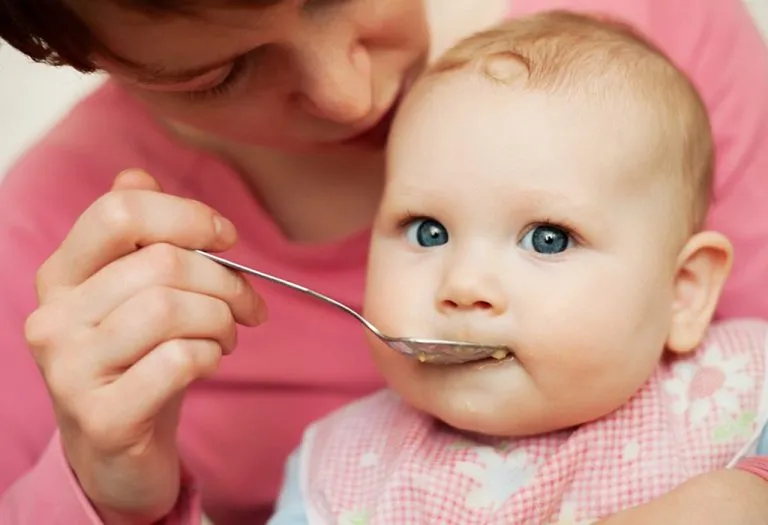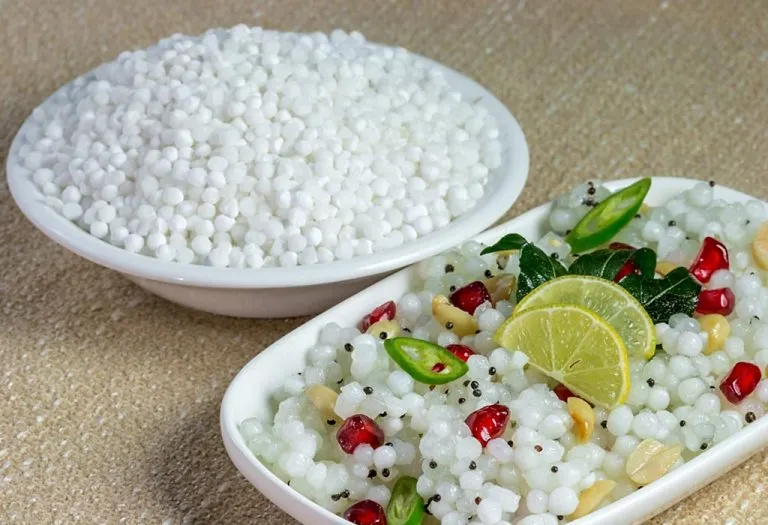Chickpeas for Babies – When to Introduce, Health Benefits, Types, and Recipes
The chickpea is a legume of the family Fabaceae. Today, India is one of the largest producers of chickpeas in the world. Chickpeas are an excellent source of plant-based protein, zinc, iron, fibre, and phosphorous. You can consume chickpeas for breakfast or you can even have them for dinner. But if you have a baby, who is a little over 6 months and you’re planning to include new foods in his diet, you will want to know when and how you can include chickpeas in his diet! Well, read on to learn all about the benefits of chickpeas for baby and how to introduce them into their diet.
Is It Safe to Give Chickpeas to a Baby?
Can babies have chickpeas? Indeed, chickpeas are deemed safe for infants. The U.S. Food and Drug Administration classifies chickpeas as “Generally Recognized As Safe” (GRAS) for consumption (1). Numerous pediatricians advocate incorporating chickpeas into a baby’s varied diet when solid foods are introduced.
When Can You Introduce Chickpeas to Infants?
Chickpeas can be introduced to babies once they reach eight months of age. However, the best time to add chickpeas to your baby’s diet is between eight and ten months of age.
Different Types of Chickpeas
Chickpeas are of two types–the large, white or beige coloured are known as ‘Kabuli chana‘ or ‘garbanzo beans’ and the smaller, harder ones are known as ‘Bengal gram’. Bengal gram can vary in colour from dark green to reddish-brown.
Nutritional Value of Garbanzo Beans
One cup of boiled chickpeas (164 grams) contains 269 calories. Find out what other nutrients chickpeas contain:
| NUTRIENTS | AMOUNT |
| Carbohydrates | 45 gms |
| Fibre | 12.5 gms |
| Protein | 14.5 gms |
| Fat | 4.2 gms |
| Vitamins | |
| Vitamin B6 | 0.2 mg |
| Vitamin K | 6.6 mcg |
| Folate | 282 mcg |
| Minerals | |
| Phosphorus | 276 mg |
| Copper | 0.6 mg |
| Iron | 4.7 mg |
| Magnesium | 78.7 mg |
| Zinc | 2.5 mg |
| Potassium | 477 mg |
| Calcium | 80 mg |
Source: https://draxe.com/chickpeas-nutrition/
Benefits of Chickpeas for Infants
The benefits of giving chickpeas to babies are umpteen. Find out how chickpeas can help in the development of your baby.
1. Helps in the Growth and Development of the Baby
Chickpeas are an excellent source of protein. In fact, chickpeas and beans are the core source of protein in a vegetarian diet. Proteins are necessary for the creation of new cells, muscle, cartilage, blood, hormones and enzymes in a baby. A growing baby needs high amounts of protein to fuel growth. Thus, giving chickpeas to a baby meets his protein requirement.
2. Helps in Brain Development
Chickpeas contain a small number of polyunsaturated fats. Unsaturated fats are essential for your baby, as they help in brain development, provide energy, and soften the skin (2). Unsaturated fats are also necessary to move around certain fat-soluble vitamins, from one part of the body to another.
3. May Help Prevent Anaemia
Chickpeas are an excellent source of iron. Iron is a necessary element for the creation of new red blood cells (3). If the body doesn’t get the requisite amount of iron, it fails to create new red blood cells resulting in a decline of active red blood cells. This condition is called anaemia. Thus, chickpeas can prevent anaemia in babies.
4. Strengthens Bones and Muscles
Calcium is necessary for the growth of bones and to maintain the health of the teeth. It also plays a role in muscle contraction and nerve stimulation in its elemental molecular form. Chickpeas contain calcium in adequate amounts and can serve as a supplementary source of calcium to milk.
5. Promotes Digestive Health
Chickpeas provide the right amount of fibre. Fibre helps bind food waste and supports proper bowel movement (4). Bacteria in the large intestine can metabolise the fibre in chickpeas to produce ‘Short-Chain Fatty-Acids’ (SCFAs). These SCFAs serve as fuel to intestinal cells, renewing their health and lowering the risk of colon problems such as colon cancer.
6. Helps in the Absorption of Nutrients From Other Foods
Your little one has a digestive system that is transitioning to solid food. It means that they need to have everything in their dietary arsenal to ensure that they get maximum nutrition. Chickpeas contain magnesium which helps the body absorb nutrients like Vitamin B and Vitamin E better.
7. Improves the Health of the Heart
The presence of soluble fibre, antioxidants and polyunsaturated fats make chickpeas valuable food to maintain the health of the heart. A moderate daily intake of garbanzo has been seen to lower LDL cholesterol, triglycerides and total cholesterol in a one-month period. While bad cholesterol levels aren’t generally associated with infant health, cholesterol levels build up throughout life. That is why children who grow up overweight are highly at risk of future cardiovascular disease.
8. Promotes Cell Regeneration
Chickpeas contain folate which is a type of vitamin. It is necessary for the recreation of DNA, which happens every time a new cell is created, making it a crucial part of cell formation and a child’s growth.
9. Lowers Risk of Diabetes
Chickpeas contain complex carbohydrates, which the body breaks down and obtains energy from slowly. Easily released energy from foods such as sugar and white rice can cause spikes and dips in blood sugar that could aggravate a child’s pre-existing condition of hypoglycaemia or type-1 diabetes. A diet rich in slow-energy-releasing carbohydrates in place of refined (fast-releasing carbohydrates) reduces the risk of type-2 diabetes in the future. This is particularly important to pay attention to if relatives, or the mother, or the father have diabetes.
10. Strengthens the Immune System
Zinc helps your baby’s immune system. It is also essential for the functioning of more than 70 types of enzymes in the body (5).
Effects of Consuming Chickpeas on Infants
Introducing chickpeas into an infant’s diet can offer numerous nutritional benefits, but it’s crucial to be aware of potential after-effects. Alongside gas and allergy concerns, other considerations should be taken into account to ensure your child’s well-being. Following are the effects of consuming chickpeas on infants.
1. Gas
Legumes such as garbanzo beans that have a high protein content can cause intestinal gas in toddlers. The severity of gas varies from person to person. It is advised to introduce chickpeas in small amounts into your child’s diet, giving their metabolic processes time to get used to the new food. A little flatulence shouldn’t be a cause for worry, however, if the severity of the gas is so high that it causes stomach pains and discomfort, stop immediately (6).
2. Allergy
Children who are allergic to soy other lentils or even latex are likely to be allergic to chickpeas (7). Also, if you have a relative with a history of allergy to chickpeas, it would be best to test for allergy in your child.
Chickpea allergy most commonly causes nasal congestion. It sometimes precipitates outbreaks of eczema or hives. In extreme cases, it could even cause anaphylaxis.
Early warning signs for intolerance:
- Acne
- Fatigue
- Loss of breath
- A running nose
- A headache
- Bloating
- Itchy skin
- Irritable Bowel Syndrome
3. Iron Absorption Interference
Chickpeas contain phytic acid, which can inhibit the absorption of iron and other minerals. To mitigate this, pair chickpeas with vitamin C-rich foods like tomatoes or bell peppers to enhance iron absorption. Additionally, consider offering iron-rich foods separately from chickpeas to ensure optimal nutrient uptake for your infant’s growth and development.
How to Select and Store Garbanzo Beans for Baby?
Choosing and storing garbanzo beans, commonly known as chickpeas, for your baby’s consumption requires attention to quality and safety. Proper selection and storage methods ensure that the beans retain their nutritional value and remain free from contaminants, promoting your baby’s health and well-being. Below are some methods to select and store Garbanzo beans for baby.
- A batch of fresh garbanzo beans will all be firm, clean and of the same colour. Do not pick if they look shrivelled.
- Choose uncooked chickpea seeds. They can easily be stored in an air-tight container or the plastic bag they come in.
- Pre-cooked or roasted chickpeas have a limited shelf life. Furthermore, roasting degrades some of its nutritional value.
- Store cooked chickpeas in the refrigerator.
Precautions to Take While Cooking Garbanzo
Follow the below steps when cooking chickpeas:
- Rinse the seeds under running water, rub them with your fingers and clean them before soaking.
- Soak raw chickpeas overnight before you cook them or they will be inedible. If you do not have a whole night, but you still do have about 5–6 hours, soak them in warm water, for quicker absorption (8). This applies to Kabuli chana as well, which being softer, requires less time for soaking than Bengal gram.
- Not all chickpea seeds may cook evenly. You may find a few of them will be relatively hard after cooking. Mash cooked chickpea before feeding it to your infant. This way you can avoid any hard ones, which could pose a choking hazard.
- Soaking in water and later cooking, will double the size of the chickpeas, so measure accordingly.
- Chickpeas are heavy, so introduce them in tiny amounts to your baby.
- If your baby doesn’t mind the taste, add ginger and garlic while cooking garbanzo. These aid digestion and reduce gas.
- Do not add softening agents like baking powder when cooking chickpeas. It will increase the sodium content of the food. High sodium in the blood is associated with weight gain, high blood pressure and linked diseases.
Homemade Chickpea Recipes for Babies
Chickpeas can be smoothly pureed after cooking, making them an excellent base for some yummy baby food!
1. Chickpeas and Vegetables Puree
Pure, natural goodness makes a smooth and healthy chickpea dish for babies.
Ingredients
- Chickpeas (Kabuli or Bengal)– 3 tbsp (soaked overnight)
- Potato (cut into small pieces) – 1 small
- Tomato (sliced) – 1 small
- Green peas (Fresh or frozen) – 1 tbsp
Method
- Pressure cook the chickpeas in about 1 cup of water for 6 whistles.
- Cook the other vegetables in a pressure cooker for 2 whistles.
- Drain the excess water from the cookers. Leave a small amount of water to mash everything well.
- Blend in a blender or mash manually.
2. Chickpeas and Peas Seasoned Puree
This chickpea puree recipe for babies is a dish that even adults will enjoy!
Ingredients
- Garbanzo Beans (Kabuli gram) – 5 tbsp (Soaked overnight)
- Peas (Fresh or frozen) – 2 tbsp
- Garlic – 1 clove
- Cumin – 1 pinch
- Vegetable oil (or any other oil, butter or ghee to sauté) – 1 tsp
Method
- Cook the garbanzo beans in a pressure cooker, with 1.5 cups of water for 6 whistles.
- Cook the green peas in a pressure cooker with 1 cup of water for 2 whistles.
- Sauté the garlic (chopped finely) and the cumin.
- Add the cooked beans and green peas, with a little bit of broth water from the green peas and mix all the ingredients well.
- Blend or mash the dish to serve!
*The garlic and cumin in this dish help with gas. The broth water is taken from the cooked green peas as removing the water from the cooked chickpeas reduces some gas-causing agents in it.
3. Chickpea and Apple Curry
This dish harmonises the distinctly sweet taste of apple and sweet potato with the savoury flavour of bell peppers.
Ingredients
- Garbanzo beans – 4 tbsp (soaked overnight)
- Potato – 1 small (diced)
- Sweet potato – 1 small (diced)
- Apple (red) – 1 (diced)
- Red bell pepper – 1 small (cut and de-seeded)
- Onion – ½ of 1 small onion (finely chopped)
- Green peas (fresh or frozen) – ½ cup
- Olive oil (can be replaced by other vegetable oil) – 1 tbsp
- Curry powder – 1 and ½ tsp
Method
- Pressure cook the chickpeas in 1 cup water for 6 whistles.
- Cook the peas in 1 cup water for 2 whistles in a pressure cooker.
- In a pan (pan with a lid is preferred), heat the oil.
- Add the potato, sweet potato, onion and the curry powder. Mix well and sauté.
- Cook with closed lid on a low flame until potatoes become tender.
- Add the red bell pepper, and the drained chickpeas and green peas. Mix it and cook on a low flame with the lid closed for another 5 minutes.
- Add the diced apple and cook it uncovered, until the apple becomes soft.
- When cooled, blend this in a mixture.
4. Chickpea Puree with Apple and Pear
The relative blandness of chickpeas helps to mix it easily into sweet and savoury dishes. This dish makes use of only the natural sweetness of the ingredients.
Ingredients
- Garbanzo beans – 1 tbsp (soaked overnight)
- Pear – 1 (diced)
- Apple Juice – 6 tbsp
- Raisins – 1 and ½ tsp
- Cinnamon – 2 pinch
Method
- Cook the chickpeas in a pressure cooker for 6 whistles. Drain and keep aside.
- Put the pear, raisins and apple juice in a pan and bring it to a boil.
- Once it achieves boiling temperature, reduce the flame and continue cooking for 2 minutes.
- Add the chickpeas and continue cooking for 3 minutes.
- Add cinnamon and puree. Use more apple juice if it is too dry to blend.
5. Chickpea, Banana and Pumpkin Puree
Another sweet chickpea dish for your baby!
Ingredients
- Pumpkin – 1 and ½ tbsp
- Chickpeas (Garbanzo beans) – ½ tbsp (soaked overnight)
- Banana – ½ of a small, ripe banana
Method
- Pressure cook the chickpeas in 1-2 cups of water for 4-5 whistles.
- Finely chop the pumpkin and cook it with a little water in a pan until it is soft and mushy.
- Blend the cooked chickpeas and pumpkin along with banana slices and serve in a bowl!
6. Chickpea and Carrot Mash
This recipe combines the mild sweetness of carrots with the nutty flavor of chickpeas, creating a nutritious and flavorful mash for your little one.
Ingredients
- Chickpeas (Kabuli or Bengal) – 4 tbsp (soaked overnight)
- Carrot (peeled and diced) – 1 small
- Vegetable broth or water – 1/2 cup
- Cinnamon – a pinch (optional)
Method
- Pressure cook the chickpeas in 1 cup of vegetable broth or water for 6 whistles until tender.
- Steam or boil the diced carrots until soft.
- Once chickpeas and carrots are cooked, blend them together in a food processor or blender until smooth. Add a pinch of cinnamon for extra flavor if desired.
- Serve the mash warm or at room temperature, ensuring it is at a suitable consistency for your baby’s age and feeding preferences.
FAQs
1. Can babies eat black and canned chickpea?
Black chickpeas are safe for babies when prepared properly and introduced at an appropriate age, typically around 6 months. Canned chickpeas are also safe but ensure they are low in sodium and preservatives. Rinse canned chickpeas thoroughly before serving to reduce sodium content.
2. Can chickpea flour be used for baby food?
Yes, chickpea flour can be used for baby food. It’s a nutritious option, rich in protein and other essential nutrients. However, ensure the flour is cooked properly to avoid any digestive issues, especially if introducing it to a young baby.
3. Do I need to cook canned chickpeas for my babies?
Yes, it’s recommended to cook canned chickpeas for babies, especially if they are being introduced to solid foods for the first time. Cooking helps soften the chickpeas further, making them easier to digest for infants. Additionally, cooking can help eliminate any potential contaminants from the canning process.
This was all about chickpeas for baby or garbanzo beans for baby. Chickpeas are an excellent food to introduce to your child. Check with your nutritious when you should include them in your baby’s diet and try the above recipes and let your baby enjoy this new food.
References/Resources:
1. GRAS Notification for Pea Protein Concentrate; USFDA; https://www.fda.gov/media/97070/download
2. Hussain. G, Schmitt. F, Loeffler. J, Aguilar. J; Fatting the brain: a brief recent research; National Center For Biotechnology Information; https://www.ncbi.nlm.nih.gov/pmc/articles/PMC3766822/pdf/fncel-07-00144.pdf; September 2013
3. Anemia in Children and Teens: Parent FAQs; American Academy of Pediatrics; https://www.healthychildren.org/English/health-issues/conditions/chronic/Pages/Anemia-and-Your-Child.aspx
4. Siva. N, Thavarajah. P, Kumar. S, Thavarajah. D; Variability in Prebiotic Carbohydrates in Different Market Classes of Chickpea, Common Bean, and Lentil Collected From the American Local Market; Frontiers; https://www.frontiersin.org/articles/10.3389/fnut.2019.00038/full; April 2019
5. Shankar. A, Prasad. A, Zinc and immune function: the biological basis of altered resistance to infection (The American Journal of Clinical Nutrition); National Library of Medicine; https://pubmed.ncbi.nlm.nih.gov/9701160/; August 1998
6. Mahmood. T, Hameed. T; Assessment of flatulence causing agents in Chickpea (Cicer arietinum L.) and their possible removal; ResearchGate; https://www.researchgate.net/publication/320611514_Assessment_of_flatulence_causing_agents_in_Chickpea_Cicer_arietinum_L_and_their_possible_removal; January 2018
7. Allergy information for: Chickpea, garbanzo, Bengal gram (Cicer arietinum ); Manchester Academic Health Science Centre; http://research.bmh.manchester.ac.uk/informall/allergenic-food/index.aspx?FoodId=21
8. Roy. A, Ghosh. S, Kundagrami. S; Food Processing Methods Towards Reduction of Antinutritional Factors in Chickpea; International Journal of Current Microbiology and Applied Sciences; https://www.ijcmas.com/8-1-2019/Anindita%20Roy,%20et%20al.pdf
Also Read:
Peas for Infants
Green Beans for Infants
Benefits of Beans for Babies
Was This Article Helpful?
Parenting is a huge responsibility, for you as a caregiver, but also for us as a parenting content platform. We understand that and take our responsibility of creating credible content seriously. FirstCry Parenting articles are written and published only after extensive research using factually sound references to deliver quality content that is accurate, validated by experts, and completely reliable. To understand how we go about creating content that is credible, read our editorial policy here.





